Physical Address
304 North Cardinal St.
Dorchester Center, MA 02124
Physical Address
304 North Cardinal St.
Dorchester Center, MA 02124
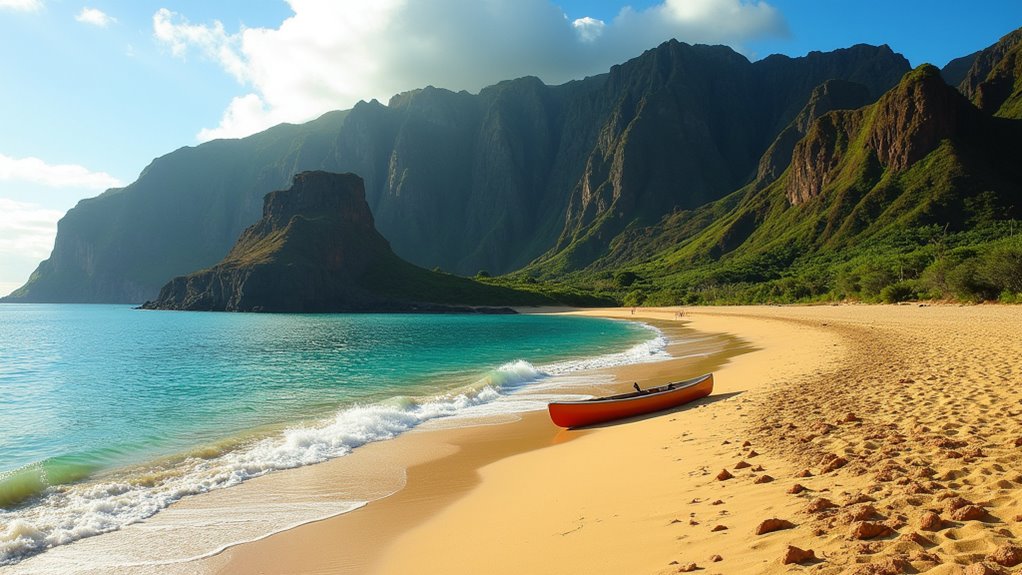
Unsure which secluded Hawaiian paradise fits your style—luxury-laden Lanai or authentically rustic Molokai?
Lanai offers luxury with Four Seasons resorts, golf courses, and developed amenities, while Molokai provides authentic Hawaiian culture with rustic accommodations and untouched landscapes. Choose Lanai for upscale comfort, Nobu dining, and curated experiences; pick Molokai for immersive community tourism and pristine wilderness. Both islands feature volcanic terrain and outdoor adventures, but differ dramatically in infrastructure and visitor services. Your preferred balance of comfort versus authenticity will determine your ideal Hawaiian escape.
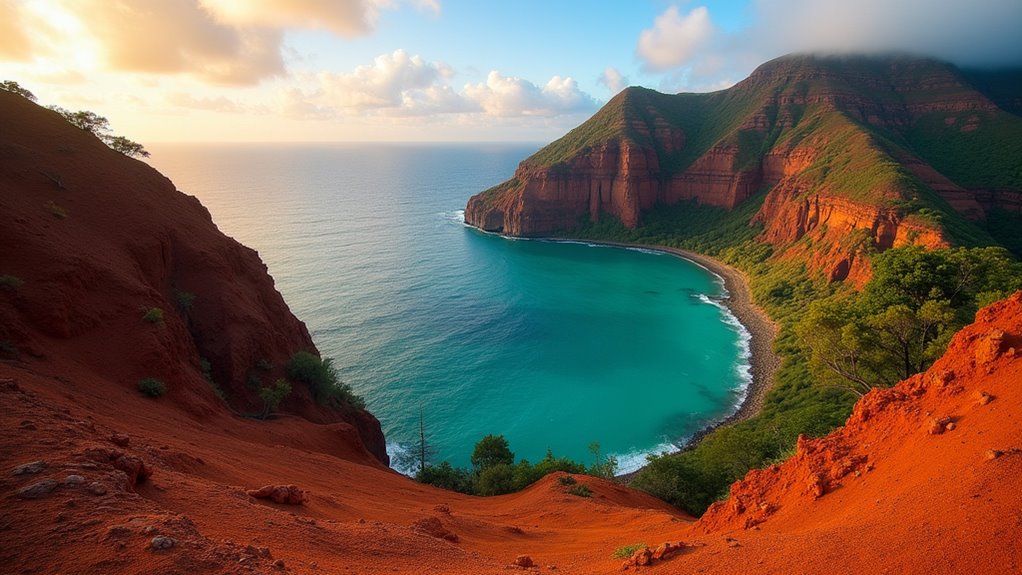
When exploring the Hawaiian islands, you’ll find Lanai and Molokai offering distinct geographic profiles despite their proximity. Lanai, the smaller island at 140.5 square miles, sits at 20°49′30″N, 156°55′12″W in the North Pacific Ocean. Its highest point, Lānaʻihale, reaches 3,366 feet above sea level. Lanai shares its geological history with a dramatic volcanic collapse approximately 100,000 years ago that triggered a massive megatsunami.
In contrast, Molokai spans about 260 square miles, nearly twice Lanai’s size, and is located at approximately 21°08′N, 157°00′W. Both islands belong to Maui County and follow traditional Hawaiian land divisions called ahupuaʻa, grouped into windward and leeward districts. While these islands are less frequented, they offer a quieter alternative to Oahu’s paradise, which draws millions of travelers annually for its blend of natural beauty and cultural significance.
Lanai’s terrain features an inactive volcano, while Molokai is known for its rugged landscapes, particularly the distinctive Kalaupapa Peninsula.
Getting to Lanai and Molokai presents a different challenge than reaching Hawaii’s more popular destinations. Both islands are accessible only via inter-island flights from Oahu, Maui, and other Hawaiian islands, with no direct mainland service.
For an authentic Hawaiian experience, discover Lanai and Molokai—secluded treasures accessible only through inter-island connections.
Lanai offers an additional option—a ferry service from Maui with three daily round trips taking about 70 minutes each way. The Expeditions Ferry provides a scenic one-hour boat ride through the Auʻau Channel, which becomes a popular whale-watching spot during winter months. Molokai has no regular passenger ferry service.
Once on the islands, transportation options are limited. Both have restricted car rental availability, with 4×4 vehicles recommended for Lanai’s largely unpaved roads. Taxi service exists on Lanai, while holoholo provides rideshare options primarily for airport transfers. Unlike Indiana with its dangerous wildlife concerns, Hawaii’s islands offer relatively safe exploration opportunities with fewer threatening animal encounters.
Book all transportation well in advance—flights, ferries, and especially car rentals can fill up quickly, particularly during peak seasons.
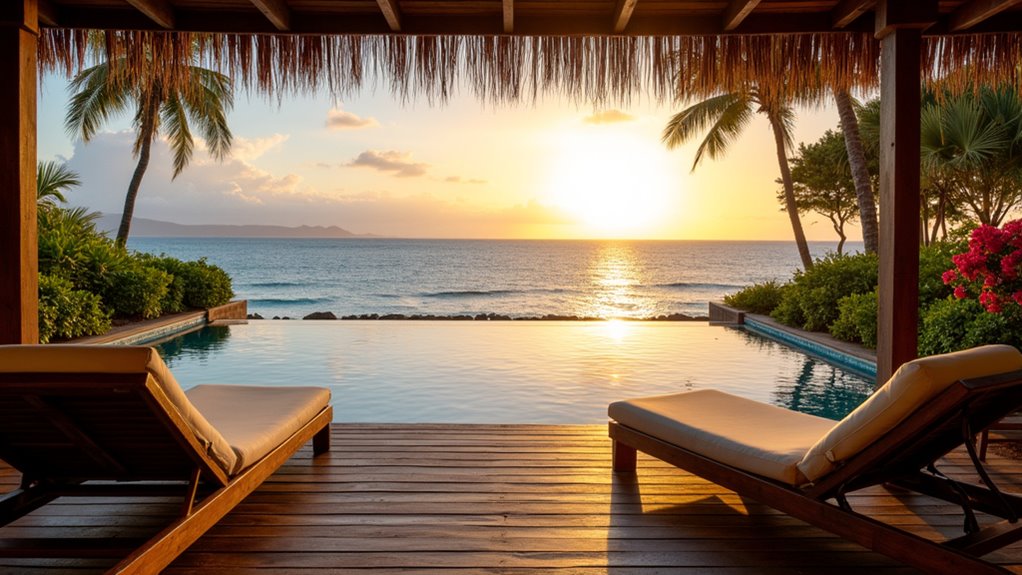
The accommodation options on Lanai and Molokai couldn’t be more different, reflecting each island’s distinct approach to tourism. On Lanai, you’ll find world-class luxury at two Four Seasons properties – the oceanfront Resort Lanai with 213 rooms and 45 suites, and Sensei Lanai, an adults-only wellness retreat. Expect AAA Five Diamond amenities: championship golf, Nobu dining, and lavish spa facilities. With its intimate 320 total rooms across accommodations, Lanai maintains an exclusive atmosphere despite its luxury offerings.
Molokai offers an entirely different experience with no large-scale resorts. Instead, you’ll stay in locally-owned boutique hotels, B&Bs, or vacation rentals that emphasize Hawaiian authenticity over opulence. While these islands differ greatly from Hawaii’s more famous surf destinations, they each offer their own unique coastal experiences.
While Lanai delivers carefully curated luxury with glimpses of local culture, Molokai immerses you in traditional community life, trading high-end amenities for genuine cultural experiences and untouched island character.
Both Lanai and Molokai offer profound connections to Hawaiian cultural heritage, though they express these connections in distinctly different ways.
On Lanai, you’ll discover 800-1000 years of Native Hawaiian history preserved through the Lāna’i Culture & Heritage Center, which actively engages the community in protecting historical sites and traditions. The island’s isolation has shaped its unique cultural identity. The Lāna’i Culture & Heritage Center hosts Aloha ‘Āina programs that deeply engage students with their ancestral connections to the land.
Lanai offers a millennium of living Hawaiian history, preserved through community dedication to cultural stewardship.
Molokai maintains stronger Native Hawaiian influences with traditional farming practices and community-based tourism that prioritizes cultural preservation.
Both islands host cultural festivals and performances like hula that celebrate their distinct heritages. When visiting either island, you’ll experience authentic community life where locals actively preserve traditions while balancing tourism impacts. Lanai offers visitors opportunities to explore pristine snorkeling spots where Hawaiian cultural practices honor the ocean’s significance.
The kapu system’s legacy and spiritual significance remain evident in daily practices and sustainable approaches to island living.
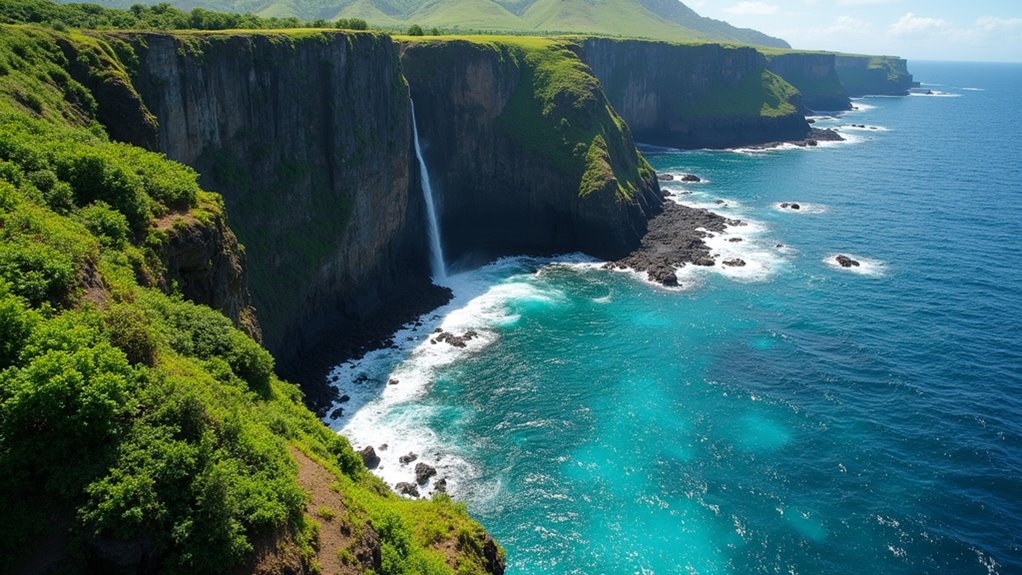
While exploring Hawaii’s smaller islands, you’ll discover that Lanai and Molokai offer dramatically different outdoor experiences shaped by their unique natural landscapes.
On Lanai, you’ll find accessible luxury adventures like ziplining over Kaiholena Gulch and golfing at the prestigious Manele Golf Course. Don’t miss Hulopoe Beach’s crystal waters for snorkeling or the otherworldly red rock formations at Garden of the Gods. Shipwreck Beach offers a scenic driving experience with spectacular views of Maui and Molokai along the way.
For hiking enthusiasts, the Koloiki Ridge Trail reveals stunning views of Maunalei Gulch. Visitors often agree that Lanai’s natural charm makes it a worthwhile addition to any Hawaiian itinerary.
Molokai presents more rugged, off-the-beaten-path experiences with its ancient Halawa Valley, dramatic coastal cliffs, and the sprawling white sands of Papohaku Beach. The island offers excellent hiking through native forests, fishing spots, and camping opportunities for those seeking authentic Hawaiian wilderness adventures.
After experiencing the natural wonders of these islands, you’ll need to understand what infrastructure supports your stay. Both Lana’i and Moloka’i face challenges with aging systems, but they offer distinctly different visitor experiences.
Lana’i provides:
Moloka’i offers a more rustic experience with:
Both islands are accessible via small airports with limited inter-island flights, and boat access provides an alternative transportation option. Unlike many other Hawaiian islands where visitors might encounter wild snakes, both Lana’i and Moloka’i have minimal reptile populations due to strict biosecurity measures. Like much of Hawaii’s infrastructure, these islands’ transportation systems are vulnerable to sea level rise that could impact coastal roads and facilities in the coming decades.
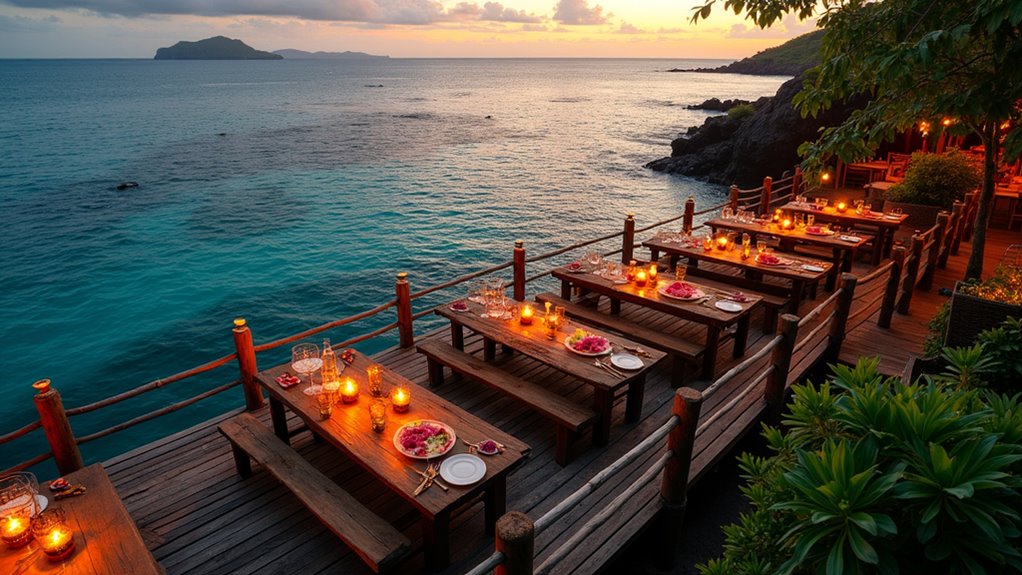
When it comes to dining, Lana’i and Moloka’i serve up distinctly different food experiences that reflect their unique island personalities.
On Lana’i, you’ll find impressive culinary diversity ranging from upscale dining at Nobu Lana’i with its Japanese seafood specialties to the more casual, local favorite Blue Ginger Cafe. The island embraces farm-to-table philosophy at Malibu Farm Restaurant & Bar, while ONE FORTY offers excellent steaks and Hawaiian seafood. Visitors seeking a perfect dining experience should consider Osteria Mozza Residency, which boasts 542 reviews and a perfect 5.0 rating.
Local ingredients shine throughout Lana’i’s restaurants, with fresh seafood, axis deer dishes, and traditional Hawaiian flavors featured prominently. Both islands offer opportunities to sample Hawaiian food culture with dishes that showcase the rich culinary heritage of the islands. Many establishments provide outdoor dining options with live music and extensive drink menus.
Remember that kitchens often close early, and some restaurants don’t operate on Sundays, so plan your dining experiences accordingly.
Deciding when to visit either Lana’i or Moloka’i depends largely on what experience you’re seeking from these tranquil Hawaiian islands.
Both enjoy pleasant temperatures between 70-85°F year-round, with the warmest months spanning June through October.
For ideal experiences on either island, consider:
While these smaller islands offer more secluded experiences, nearby Kauai is worth visiting during shoulder seasons for those seeking a perfect balance between accessibility and natural beauty.
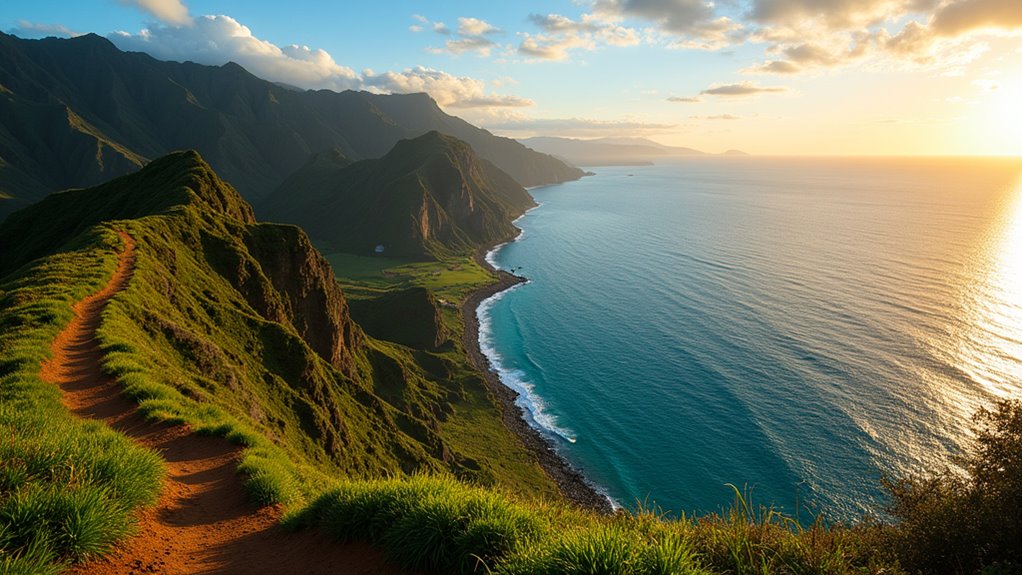
Planning an island-hopping adventure between Lana’i and Moloka’i requires thoughtful preparation to maximize your experience on these distinctly different Hawaiian gems.
Arrange transportation well in advance—book commuter flights between islands or coordinate ferry schedules if traveling via Maui. Remember that Mokulele Airlines offers about 10 daily flights connecting the islands through Maui and Oahu hubs. Consider using interisland flights as the most time-efficient way to explore multiple Hawaiian islands during your vacation. You’ll need rental cars on both islands since public transport is minimal.
If you’re seeking luxury, start with Lana’i’s Four Seasons resorts and world-class golf before experiencing Moloka’i’s more rustic authenticity at Hotel Molokai.
For budget travelers, consider visiting Lana’i as a day trip from Maui via ferry.
Allow at least two days per island to explore their natural highlights: Hulopoe Bay and the Munro Trail on Lana’i; Kalaupapa National Historical Park and Halawa Valley on Moloka’i.
Both Lana’i and Moloka’i offer photographers an extraordinary canvas of natural wonders and hidden treasures waiting to be captured. Lana’i presents more upscale settings like Hulopoe Beach’s picturesque sunrise views and Garden of the Gods’ surreal rock formations that glow at sunset. The iconic Puʻu Pehe Trail offers spectacular sunset photography opportunities with views overlooking Sweetheart Rock and connects with the Hulopoʻe-Huawai Fisherman’s Trail.
Moloka’i, meanwhile, delivers rugged landscapes through Halawa Valley’s lush scenery and Papohaku Beach’s serene expanses. For those seeking dramatic natural settings, Kauai’s coast provides breathtaking backdrops with its verdant cliffs and pristine beaches.
For off-the-beaten-path experiences, consider:
Each island provides distinct photographic opportunities: Lana’i with more accessible, developed areas and Moloka’i with its untamed natural beauty.
Whether you choose Lanai’s polished luxury or Molokai’s rugged authenticity, you’re stepping into Hawaii beyond the postcard. Each island offers a treasure chest of experiences waiting to be unveiled. Trust your gut—the island that calls to your spirit won’t lead you astray. Pack light, but bring your curiosity and respect. Hawaii’s lesser-known sisters don’t reveal their secrets to everyone—only to those who truly listen.